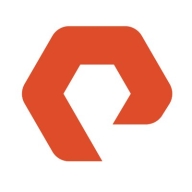


NetApp AFF and IBM FlashSystem are competing in the enterprise storage category. IBM FlashSystem appears to have the upper hand due to its robust features, despite NetApp AFF’s favorable pricing and support.
Features: NetApp AFF has strong data management, high performance, and seamless integration with various environments. IBM FlashSystem offers reliability, advanced data reduction features, and scalability. IBM FlashSystem’s feature set is more robust and flexible, making it favorable for users needing extensive capabilities.
Room for Improvement: NetApp AFF could enhance snapshot management and reduce setup complexity. IBM FlashSystem needs a more intuitive management system and better software updates. NetApp AFF faces operational complexities, while IBM FlashSystem’s issues are less critical.
Ease of Deployment and Customer Service: NetApp AFF deployment is complex and time-consuming, but customer service is responsive and of high quality. IBM FlashSystem is straightforward to deploy, with excellent customer service supporting the setup.
Pricing and ROI: NetApp AFF has competitive setup costs and favorable ROI, balancing cost and performance. IBM FlashSystem is pricier but justifies the cost through superior features and robust ROI. NetApp AFF is more budget-friendly, while IBM FlashSystem's higher expenditure is valuable due to its comprehensive capabilities.
If you wait more than seven years to buy another one, you get a return on your investment.
The solution can comfortably be stretched from five to seven years without any failures, ensuring a long-lasting return.
We have seen return on investment compared to other OEMs, which took approximately three years after implementing IBM FlashSystem.
Customers always have their issues resolved promptly.
Technical support is good at least through vendors, not directly with the principal.
Customers of alternatives like Dell and Hitachi enjoy more reliable and comprehensive support services directly from vendors rather than third-party subsidiaries.
I rate the technical support from IBM as a ten.
IBM customer support is responsible, efficient, and responsive, though it is expensive.
The support for NetApp AFF is comprehensive—not just the documentation for self-guided reading, but for simple questions, spare parts, or urgent needs, you can have a contract that enables delivery the next business day or within four hours, depending on your process requirements.
I have communicated with them, and they are effective and responsive.
It hasn't broken down anytime in the last six to seven years, despite hurricanes, earthquakes, and power outages.
For larger enterprises, scalability is an issue as the price becomes prohibitive.
The problem arises when migrating data to a later IBM FlashSystem version due to issues with firmware compatibility.
The scalability of IBM FlashSystem is exceptional, and I rate it as a nine.
You can add more disks, more disk shelves, or migrate the data seamlessly.
I would assess the scalability of NetApp AFF as excellent in handling massive data volumes.
I would rate the stability of the product at seven out of ten.
Customers have infrastructure that is 100% stable.
The firmware and software engine have fewer bugs, which enhances operational efficiency.
They have always been upgrading very fast and implementing patches to resolve these issues.
One way to improve the product is to add an operational assistant that doesn't depend on VMware.
I would like to see some AI features that would allow arrays to intelligently identify threats or unusual behavior in the data pattern and give an alert.
Storage replication should be essential.
Despite marketing promises, these features do not function effectively and can impact performance.
There is room for improvement in the troubleshooting part, specifically related to IBM Spectrum for Insight.
An additional function that could be helpful is reducing the time it takes to delete volumes, especially if they are compressed or deduplicated.
The GUI of ONTAP Command Manager could be better, but the CLI is perfect.
Our backup system, Commvault, has an amazing capacity to do compression and deduplication better than NetApp AFF by itself.
All of this is the same for all product ranges, whether E-series, NetApp AFF, or FAS series, because they are very efficient to respond.
While the prices may be higher than those of other vendors, we see it as a market leader with benefits.
The support can be a bit pricey, but the solution is more cost-effective than anything else out there.
To install or upgrade any software features, the cost is high, which makes it challenging for smaller companies who do not require advanced features like deduplication or compression typically needed by larger organizations.
The pricing is high; storage solutions are always expensive.
NetApp support is cheaper than Dell support.
While it is not cheap, they have introduced a new series of AFF that are more affordable.
The licensing cost of the product is expensive, and when combined with support, it becomes quite costly.
Its data compression feature is the best that we have ever seen.
Pure FlashArray X NVMe helps to improve our processing speed.
We are satisfied with the performance as it is significantly faster compared to traditional storage options.
There is a significant amount of data reduction, achieving a ratio of one to three.
The most valuable features are performance and reliability.
There is built-in compression, a data reduction feature, and artificial intelligence-driven insights that calculate warnings and errors to redirect to customers automatically.
You can even download the ONTAP simulator and deploy it on your virtualization platform and test almost all features.
Data reduction capabilities such as deduplication, compression, and compaction are standard features included with the license in NetApp AFF.
They have 4:1 data reduction techniques, which is really very high. If you have a size of 100 terabytes, you will get 400 terabytes of usable capacity when applying compression, deduplication, or other data reduction technologies.
| Product | Market Share (%) |
|---|---|
| NetApp AFF | 8.8% |
| IBM FlashSystem | 5.8% |
| Pure FlashArray X NVMe | 1.4% |
| Other | 84.0% |



| Company Size | Count |
|---|---|
| Small Business | 15 |
| Midsize Enterprise | 11 |
| Large Enterprise | 12 |
| Company Size | Count |
|---|---|
| Small Business | 47 |
| Midsize Enterprise | 21 |
| Large Enterprise | 59 |
| Company Size | Count |
|---|---|
| Small Business | 45 |
| Midsize Enterprise | 47 |
| Large Enterprise | 242 |
Pure Storage FlashArray//X is the world’s first enterprise-class, all-NVMe flash storage array. It represents a new class of storage – shared accelerated storage, which is a term coined by Gartner – that delivers major breakthroughs in performance, simplicity, and consolidation.
IBM FlashSystem products are enterprise computer data storage systems that store data on flash memory chips. Unlike storage systems that use standard solid-state drives, IBM FlashSystem products incorporate custom hardware based on technology from the 2012 acquisition of Texas Memory Systems. This hardware provides performance, reliability, and efficiency benefits versus competitive offerings.
The NetApp A-Series and C-Series are AFF storage arrays that deliver high performance, scalability, and simplified data management for a wide range of workloads. They are designed for organizations that need to improve the performance and agility of their applications, while also reducing costs and complexity.
NetApp A-Series and C-Series feature a scale-out architecture that can be scaled to meet the needs of your growing business. They also support a wide range of built-in data protection and data security features, including snapshots, replication, disaster recovery, and autonomous ransomware protection.
AFF A-Series all-flash systems deliver industry-leading performance, density, scalability, security, and network connectivity.
AFF C-Series systems are suited for large-capacity deployment as an affordable way to modernize your data center to all flash and also connect to the cloud.
NetApp AFF Benefits
NetApp AFF Features
Reviews from Real Users
NetApp AFF stands out among its competitors for a number of reasons. Two major ones are its high performance and simplicity. PeerSpot users take note of the advantages of these features in their reviews:
PeerSpot user and Storage Administrator, Daniel Rúnar Friðþjófsson, comments “AFF has helped to simplify our infrastructure, while still getting very high performance for our business-critical applications. Having all these things working well on one solution is really good. We run this as the backbone for both Hyper-V and VMware as well as an archive location for Rubrik. So, it is great having one solution that can do it all.
Because of the ease of it all, you have a highly tunable, high-performance storage system that alleviates a lot of problems. With its ease of management, you can quickly get your work done and go onto the next thing on your list.”
Additionally, Mohan Reddy, Sr. Technology Architect at a Pharma/Biotech company comments on how “NetApp's ONTAP data management software has also made tasks simpler for us. There's no question about that. It has helped us run operations very quickly, saving us a lot of time. Before ONTAP, we used to spend a long time doing regular operations, but with the latest version of the tool, our day-to-day operations are much quicker and easier.”
We monitor all All-Flash Storage reviews to prevent fraudulent reviews and keep review quality high. We do not post reviews by company employees or direct competitors. We validate each review for authenticity via cross-reference with LinkedIn, and personal follow-up with the reviewer when necessary.